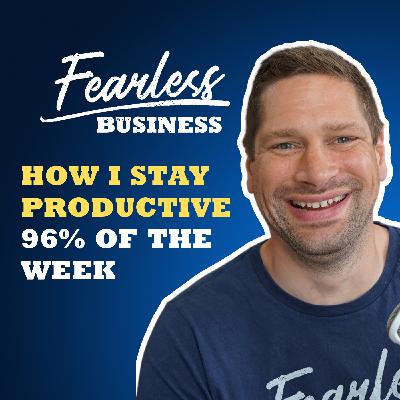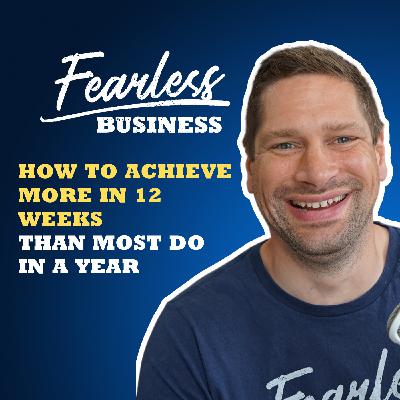How I Stay Productive 96% of the Week
Description
Are you struggling to check off your endless to-do list or feeling overwhelmed by the grind of running a business? In this episode, Robin dives into Matt Essam’s 3 F’s Framework, a simple yet powerful productivity system to help you run your business with purpose and joy while maintaining balance in your life.
Debunking Modern Productivity Myths
If you've ever fallen down a YouTube rabbit hole of “Rise and Grind” entrepreneurs or found yourself wondering if you’re doomed because you don’t wake up at 5 a.m. sharp, you’re not alone. There’s a persistent myth in modern work culture that productivity and success are forged purely in the fires of relentless self-discipline, think early alarms, endless hustle, and powering through even when every cell in your body would rather nap.
But here’s what actually moves the needle: sustainability and joy. Yes, sometimes you have to tackle boring admin or wrestle with your inbox, but success isn’t about surviving a never-ending bootcamp. In fact, research highlights that our best work tends to happen when we’re not drowning in stress, but when we’re genuinely enjoying the process.
Consider this: The creators, founders, and authors who make it big (think enduring YouTube channels, bestselling authors, or decade-strong companies like Patagonia or Basecamp) are almost always the ones who fall in love with the day-to-day journey, not just the distant finish line. If you’re in it for the long haul, burnout simply isn’t an option.
So, rather than obsessing over “hacks” or brute-forcing your way to success, the real secret is designing your workflow and business around what energizes you. If you’re energized by what you do, you’re not only more creative and productive, you’re actually more likely to stick with it long enough to enjoy the real rewards.
What You'll Learn in This Episode:
Freedom: Discover how to structure your work-life balance to maximize productivity while enjoying guilt-free time off. Learn how sprint cycles, intentional scheduling, and prioritizing self-care can give you the flexibility you’ve been craving.
Fulfillment: Uncover the secret to finding purpose in your work and why chasing money alone often leads to burnout. Explore strategies to create meaningful impact through your business, including giving back and aligning your work with your passions.
Finance: Master the art of intentional financial planning by applying the Pareto Principle (80/20 rule) and doubling down on high-impact activities that drive revenue and growth. Whether it’s optimizing revenue streams or focusing on hyper-productive marketing strategies, this episode breaks it all down.
Packed with actionable insights, this episode will inspire you to rethink your approach to productivity, giving you the tools to run a thriving business without sacrificing your freedom or happiness.
The Surprising Link Between Exercise and Peak Productivity
Ever wondered if hitting the gym could give your work life a boost? Turns out, there’s more to those morning sweat sessions than just physical health, they can genuinely supercharge your productivity elsewhere, too.
By committing to regular workouts, especially first thing in the morning, you’re not only prioritizing your well-being but also setting the tone for a more focused and energized day. Many people, myself included, find that starting the day with movement increases motivation, mental clarity, and determination to tackle even the most daunting work tasks.
For example, after reading Peter Attia’s Outlive and taking my fitness more seriously as I approached 30, I noticed a tangible improvement in my output. Consistent exercise routines, like heading to the gym four times a week, make it easier to establish sustainable habits and maintain momentum, not just in fitness but across all areas of business and creativity.
Whether it’s brainstorming fresh content or powering through challenging projects, the discipline and energy you build from regular exercise tend to spill over into your professional life. So if you’re looking to boost productivity, don’t overlook the potential of a strong morning workout routine.
Overcoming Procrastination with Simple Scheduling
One of the most effective ways to defeat procrastination is surprisingly straightforward: just put your tasks on the calendar. The act of deciding exactly what you need to do, and blocking out the specific time to do it, removes ambiguity and makes it much harder to endlessly defer important activities.
Instead of letting tasks linger on a vague to-do list (“Update LinkedIn,” “Hire a virtual assistant,” “Write next week’s newsletter”), clarify your next action and give it a defined time slot. For example, “Schedule 30 minutes at 10am on Wednesday to brief the new social media freelancer.” This tiny shift transforms intentions into commitments.
Why does this work? Because seeing an item in your calendar as an actual appointment turns it from a nagging thought into a scheduled activity, one you’re far more likely to complete. No more decision fatigue or last-minute shuffling. It’s in the diary, just like your call with a client or trip to Pret for the essential flat white.
This approach is all about simplicity. By getting granular and giving every task a home, you’ll find that action comes more naturally, and you’ll finally tick off those long-standing bullet points that have taken up permanent residence on your to-do list.
Why Guilt Creep Can Sabotage Your Hustle
Ever step away from your laptop only to catch yourself feeling oddly guilty about not working on your side project or business? You’re not alone. Many entrepreneurs and creators stumble into a guilt trap, convinced that every moment not spent “being productive” is a moment wasted, or worse, a potential setback.
This feeling often sneaks in from a certain type of motivation: the drive to avoid negative emotions rather than pursue positive goals. Instead of working because you genuinely want to, you might end up working just to dodge that nagging voice saying, “If you don’t do this, you’ll let yourself down.”
Common triggers for this guilt include:
- Worries about financial security. The fear that your income isn’t where you want it to be, or that taking a break could jeopardize your business, can keep you tethered to your desk.
- Concerns about status or reputation. There’s a natural anxiety about what others, family, friends, or even old coworkers, might think if your business doesn’t pan out.
- Looming responsibilities. Whether it’s the rising cost of living or dreams of providing more for your family, these pressures can amplify the sense that you should always be “doing more.”
Ultimately, these guilt-fueled work marathons rarely end well. Over time, they can drain your energy, dampen your enthusiasm, and yes, fast-track you straight to burnout. Recognizing the source of this guilt can be the first step to working with more intention, and a lot less stress.
Finding Autonomy in the Everyday
Even if you’re not the one deciding what gets done at work, there’s still a surprising amount of power in how you approach your daily tasks. Reflect on moments like childhood, the sheer joy you felt personalizing a bedroom or perfecting a school project. That same spirit can bring a spark of motivation and ownership to even the most routine assignments.
Can’t choose your to-do list? No problem. Channel your energy into improving the process. Maybe it’s organizing your workflow with color-coded notes, streamlining boring administrative work by developing templates, or embracing new tech to speed things up and impress the team (think wielding a tablet like a pro in those endless meetings). Often, making small tweaks that suit your style doesn’t just lighten your own load, it can turn heads and inspire colleagues, too.
By focusing on how you do your work, not just what you’re told to do, you unlock a sense of autonomy. It’s about taking the reins over the experience itself, crafting pride in the details, and discovering a sense of accomplishment in every task, no matter how prescribed it might seem.
Finding Freedom Through Autonomy
When it comes to gaining more autonomy at work, it’s less about making a dramatic leap and more about smart, intentional tweaks to the way you approach your day. If you’re craving more freedom and flexibility, here are a few practical strategies to get started:
Redesign Your Schedule: Start by experimenting with how you structure your work hours. Try blocking off “focus time” for deep work, or use sprint cycles (short, intense bursts of productivity) to give yourself defined periods of high output, followed by guilt-free downtime.
Set Boundaries, And Stick To Them: Communicate your working hours clearly to clients, colleagues, or customers. Protect your time for lunch breaks, family, or even that midday walk. The key is consistency; when your boundaries are clear, others are more likely to respect them.
Delegate or Automate: Identify repetitive tasks that drain your energy. Can you use tools like Zapier or Notion, or delegate chores to a virtual assistant? Offloading low-impact activities creates more space for the work, and life, that really matters.
Prioritize Tasks That Energize You: Take stock of tasks that make you feel most in control or inspired, and intentionally add more of these into your routine. Whether that’s creative brainstorming, connecting with your team, or learning new skills, lean into what lights you up.
Embrace Your Locus of Control: Sometimes, autonomy isn’t about a new job, it’s a new mindset. Focus on the choices you























